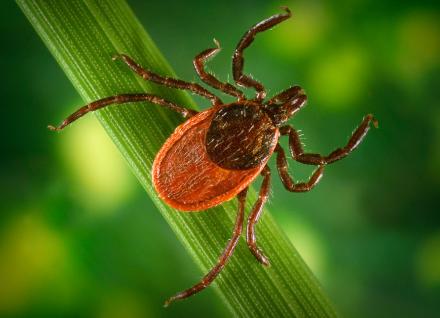
We originally published this piece on tick prevention and removal in early summer 2018.
***
By Maryellen Apelquist
Tick season is in full swing in Vermont, bringing with it tick-borne illness, such as Lyme and West Nile, diseases which are on the rise across the United States according to the Centers for Disease Control (CDC). Dr. Lou DiNicola, a pediatrician and medical director of primary care at Gifford Health Care, offers Vermonters tips for tick prevention and removal, identification of symptoms of tick-borne illness, and advice on when to call your health-care provider.
According to a recent CDC report, “disease cases from mosquito, tick, and flea bites more than tripled in the U.S. from 2004 to 2016.” In Vermont, the Department of Health reports that the number of residents diagnosed with a tick-borne disease likewise tripled, from about 300 cases in 2008 to nearly 1,000 in 2016. The greatest percentage of Vermont cases are reported in June and July.
“We see our share of cases in Vermont, and the frequency is increasing,” said DiNicola. “Lyme disease is by far the most common tick-borne illness in the state, making up the vast majority of tick-borne diseases. In fact, in 2016 Vermont had the second-highest per-population rate in the country—78/100,000—meaning Vermonters had about a .08 percent chance of getting Lyme disease last year.”
Key to avoiding risk of infection is prevention.
“Avoid tall grass, wear long-sleeve shirts and long pants that are light in color, so you can see the ticks, and perform tick checks,” said DiNicola.
“Tick repellents also may be used,” he said. “At a concentration of no more than 30 percent, Deet applied to the skin is effective, but it needs to be reapplied every hour or two. It should not be applied to the face, and should be washed off once you return indoors. For those who must work outdoors daily, the insecticide permethrin—applied to clothing only—is very effective, but it should not be used regularly by others.”
DiNicola also recommends showering and washing hair immediately after spending time outdoors. “Ticks tend not to embed themselves right away. Rather, they roam across the body to find the tastiest spot, so you may have time to wash them away.”
“For example, ticks can advance from your ankle to the back of your knee, a favorite spot to settle in for a few days of their blood meal,” DiNicola said.
Because ticks are tiny at the stage during which they transmit Lyme disease—only a little larger than 1/16 of an inch—and will explore a body to find an ideal location, it is important to check closely for ticks from head to toe. Additionally, tick bites are not painful and will not be felt “until you discover the attached freeloader,” DiNicola said.
Ticks that have not embedded may be easily removed from skin and destroyed. If embedded, DiNicola said, “use small tweezers, or a Ticked Off™ tool, by grasping the tick as close to the skin as possible and slowly and steadily pulling the tick from your skin. It is OK if parts of the head of the tick remain in your skin.”
“You also can visit your health-care provider, and they or their dedicated nurse or medical assistant can remove it,” he said.
If infected, the classic symptom of Lyme disease is erythema migrans, a single bull’s eye-shaped lesion, which may appear a few days to a month after the tick bite. “Anyone with this rash should be treated,” DiNicola said. “There is no need for testing at this point, as it would be too early for accurate results.”
“Early-disseminated Lyme disease presents with generalized symptoms including, but not limited to, multiple skin lesions, meningitis, facial palsy, and carditis [inflammation of the heart],” he said. “These patients will have serologic tests positive for both IgM and IgG antibodies. Late disease usually presents with arthritis and positive IgG antibodies.”
The good news is that Lyme disease is curable. Children 8 years old and younger may be treated with amoxicillin or, if allergic to amoxicillin, cefuroxime. Older children and adults may be treated with doxycycline or amoxicillin, or cefuroxime if allergic to amoxicillin.
For more information about ticks and tick-borne illness, visit healthvermont.gov/disease-control/tickborne-diseases.

